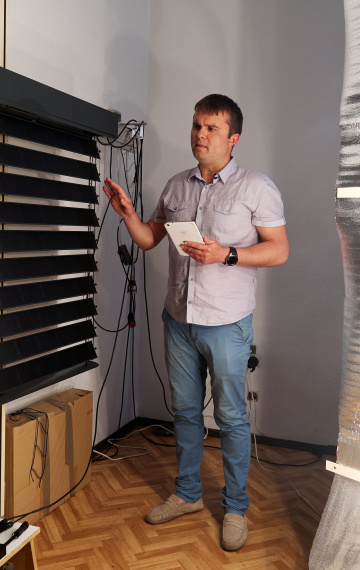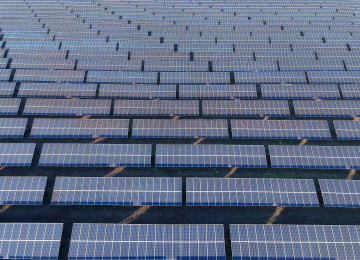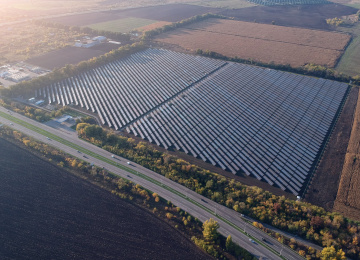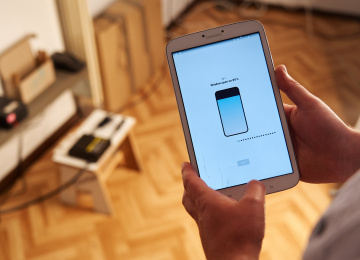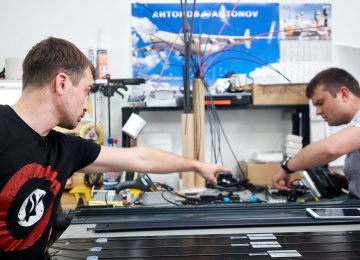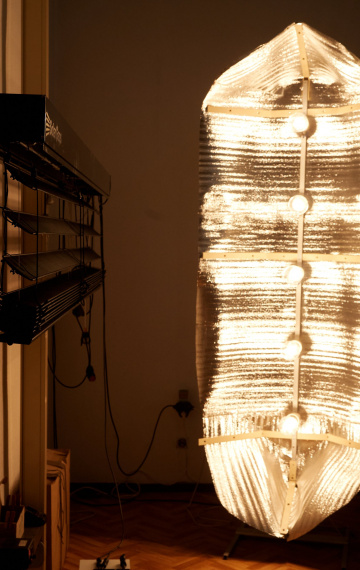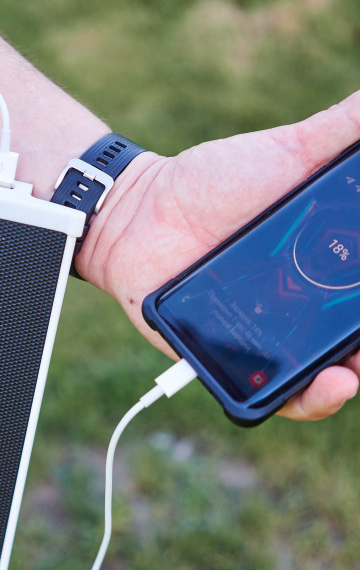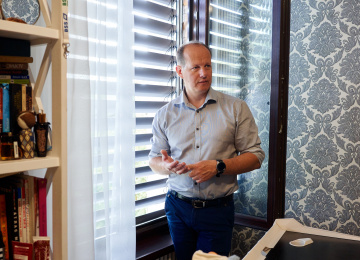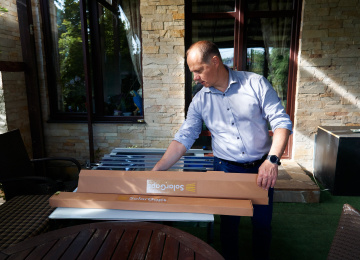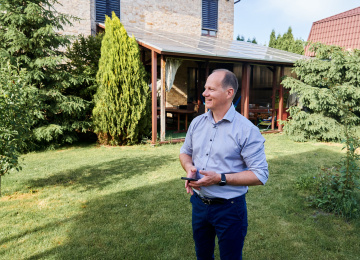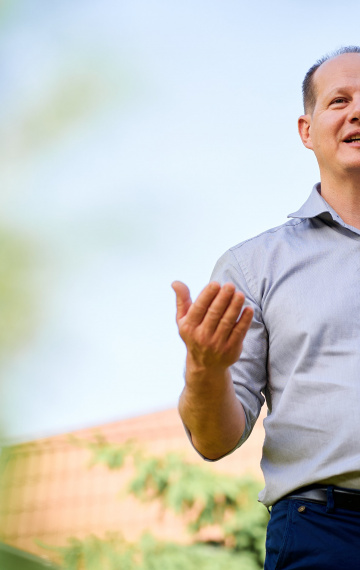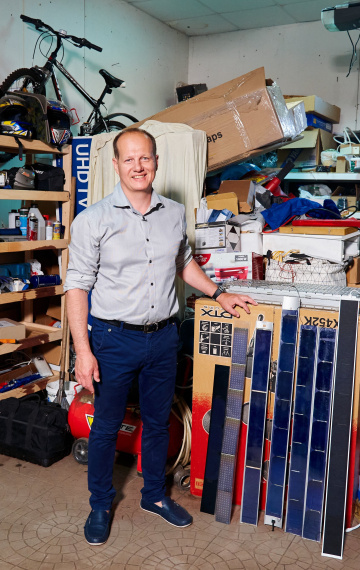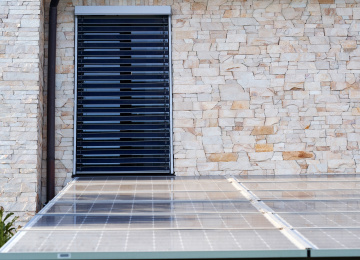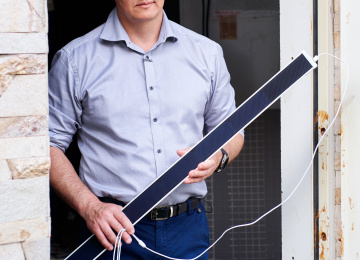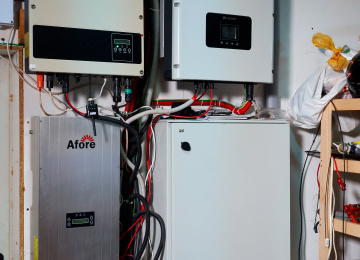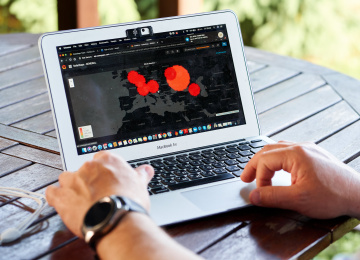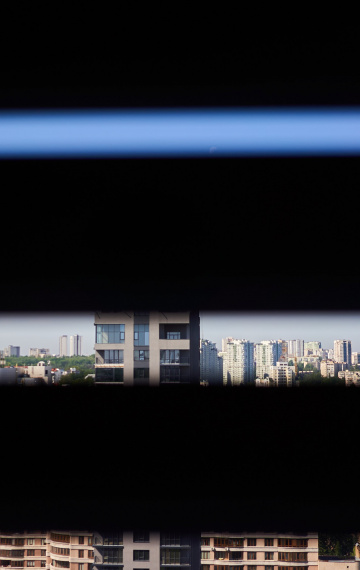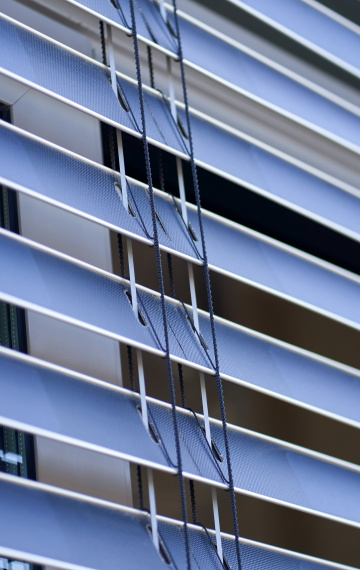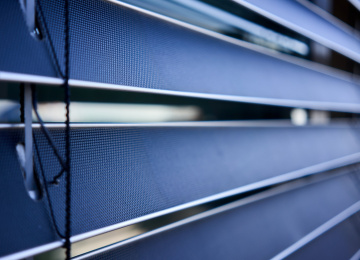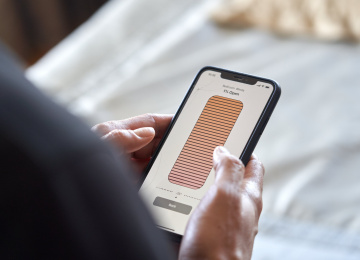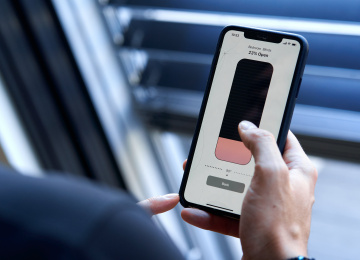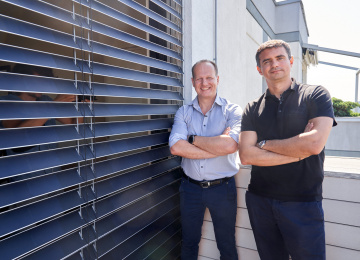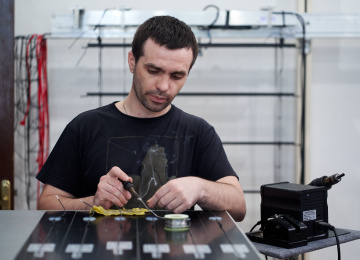
Yevhen Erik, an entrepreneur, was looking for more efficient uses of energy for his house and came up with a great solution for millions of other homes in addition. Today, Ukrainian window blinds that generate power from sunlight are in demand around the world. Their inventor believes that the company’s clients will soon create their own power grid and be able to begin exchanging the accumulated energy.
Long ago humanity used sunrays to start fire or to heat water. As natural resources gradually become exhausted, the use of solar power turns out to be one of the ways to save our planet. Scientists learned to turn solar power into electricity and use it for home heating.
The sunlight can be collected by mirrors or photoelectric panels. And while the first approach is mostly used on an industrial scale, the photoelectric (or solar) panels can often be seen on rooftops and on the ground of private premises.
A global experience
Following the energy crisis of the 1970s, many western countries set a course for “green” energy use. Back then OPEC (Organization of the Petroleum Exporting Countries) deliberately cut oil production to increase its price. At the same time, Arab countries refused to supply oil to any of Israel’s supporters, because of the ongoing conflict between Israel, Syria and Egypt. The USA suffered the most from this crisis and so that country was the first to act. Jimmy Carter, the US president at the time, even requested to put up solar panels on the White House’s rooftop, in support of the national energy saving programme.
The global climate keeps changing, mostly because of CO2 emissions, which cause a rise in global temperature. This is why in 2015 at the United Nations Climate Change Conference in Paris, 195 countries declared their intentions to reduce greenhouse gas emissions and increase the use of renewable energy. The share of renewable resources such as sunlight, wind, water, waves and tides, biomass and geothermal heat in global use has been gradually increasing since then.
Solar energy dominates all other renewable resources. According to an analysis made by the International Energy Agency (IEA) in 2016, its capacity increase showed the greatest momentum when compared to other energy sources worldwide. China (which became the leader in just five years), USA, Japan, Germany and India are considered to be among the “solar” leaders. Because of its high popularity, sustainable energy is becoming more accessible and even cheaper than traditional sources every year. According to the forecast of the Greentech Media research centre, by 2022 the cost of solar energy will be reduced by 27% compared to 2017 figures. The International Energy Agency, at the same time, suggests that by 2050 the sun will become the main source of energy, which in return will lead to the reduction of CO2 emissions by over 6 billion tonnes per annum.
Solar energy in Ukraine
In 2019 Ukraine jumped from 63rd to 8th place in the “top developing countries for attracting clean energy asset finance” ranking (according to the annual report by Bloomberg New Energy Finance). How so? Firstly, Ukraine’s favourable climate ensures good levels of insolation (the amount of solar radiation reaching a given area) around all of the country’s regions. That means that solar panels installed in Kherson, in the south, will be as effective as ones set up in Chernihiv, in the north. Secondly, the government’s legislative initiatives incentivise using renewable sources. The parliament in 2009 ratified the law “On alternative sources of energy”, which committed the state to buy electric energy at a special “green tariff” (which was subject to periodic reviews) from anyone who produced it from renewable sources. In 2020 this “green tariff” is €0.16 per kW for private solar power stations, which makes it the highest tariff in Europe.
The Russian-Ukrainian war in Donbas and the intention to escape Russia’s influence, which had been one of the key suppliers of oil and natural gas to the country, played a vital role in the change of priorities in Ukraine’s energy policy. Before 2014, when Ukraine was mostly utilising traditional sources of energy, in Crimea some sustainable power plants were built; they used solar and wind energy. After the occupation of Crimea by Russia nearly all solar power stations ceased their operations. The newcomers built two thermal power stations instead.
Under these circumstances Ukraine decided to give a second chance to its former inland energy centres. As a result, in the Chornobyl exclusion zone, not far from the former atomic station, thousands of solar modules have been installed, which now produce nearly 1,024 MW per annum; also in Slavutych, yet another town of nuclear engineers, the first cooperative solar station was opened, which turned the place into a so-called “solar” town.
Every year dozens of new solar power stations are put into operation. Apart from their mostly positive impact, large solar power stations have a number of disadvantages. Solar farms of high capacity occupy vast areas (1 MW requires 1.5 ha of land), and they concentrate a lot of energy in one location. This means the regions that produce a lot of solar energy need to transmit it to underpowered places. This incurs additional expenses for transmission and leads to a higher load on the grid as well as power losses. In order to keep the energy balance, it is important to distribute power generation. It is more beneficial to have smaller solar power stations scattered across the town, installed on private rooftops, than to have one big solar farm stretching for dozens of hectares.
But not everyone can install a solar panel on their rooftop — simply because not everyone has a rooftop. There are some small portable solar panels available on the global market — they come with power banks, backpacks, and clothing, and some types can be put on street lamps. But they do not solve the problem of being dependent on traditional sources of energy. In 2015 Yevhen Erik, an entrepreneur from Ukraine, along with his team devised a solution to this problem, which they called SolarGaps.
Sunflowers on a window
Yevhen Erik, a founder of the SolarGaps company, has always promoted effective and environmentally friendly uses of energy. Initially he intended to modernise his own house and make it energy efficient. He installed solar panels, as well as solar collectors used for heating the water, but the energy consumption levels remained high. It was then when Yevhen came up with an innovative solution that produces energy no less efficiently than the solar panels, and eliminates the need for air conditioning.
SolarGaps are window blinds equipped with photovoltaic modules, which can be installed on the outer side of a window. Solar panels act as the blinds’ slats and collect the energy from sunlight, while the product itself provides the optimal shade for the premises. This solution from SolarGaps allows its owners to eliminate air conditioning, which is known for its high level of energy consumption and could also be harmful when used without proper maintenance. (If air conditioning filters are not cleaned or replaced in time they may harbour harmful bacteria, dust, dirt or chemical particles that enter the premises with the fresh air.) The use of solar energy instead of traditional fossil fuel also helps to reduce the levels of greenhouse gases emissions. In this way, 1 m2 of solar blinds can prevent emissions of 110 kg of CO2 per annum. Emissions can be reduced even further by saving more energy through shading the premises.
The blinds’ working principle is similar to sunflowers’ movement towards the sun:
— SolarGaps track the sun just like sunflowers do. The idea of the flowers’ movement became my inspiration — it came to me as I was driving on a motorway from Kyiv to Odesa.
The blinds automatically follow the sun to collect as much of the energy as possible. The collected energy can be used to power any electrical appliances or lighting. This is done by a special inverter — a device which is plugged into the premises’s power grid to translate the solar energy from DC to AC. The SolarGaps solution helps to reduce the electricity bill by 30-40%.
If solar blinds generate more energy than required it can be sold back to the grid at the “green” tariff. Selling the excess energy helps reduce the time lag between the investment into the blinds’ installation and breaking even on the costs to only six years instead of ten. This energy can also be accumulated by a separate battery. This battery can later be used for charging a smartphone or a notebook. Just 1 m2 of these solar blinds produces up to 100 W per hour. This is enough energy to charge up to 3 notebooks or to power about 20 light bulbs.
Solar blinds are often plugged into the smart home infrastructure by their owners. They can be controlled remotely via an iOS or Android smartphone app, and also support voice or gesture control via Google Home or Amazon Alexa virtual assistants.
— Our reasoning with these blinds was to ensure they integrated naturally into their owners’ habits.
Among the non-core features of SolarGaps are the alarm clock function or an evening privacy keeper. These solar blinds are safe for children and also weatherproof.
From idea to solution
At first, Yevhen was trying to fulfil his idea on his own: he was buying various types of solar modules to analyse their effectiveness, and he tried assembling his first prototypes without any blueprints. The first major step for Yevhen became his participation in IoT Hub’s hackathon (the event is organised by a Kyiv accelerator lab, which helps start-ups to enter Ukrainian and global markets), where he met Roman Kravchenko, his future partner. Roman offered to go through an acceleration programme — an intensive learning course on business development that comes with expert and financial support.
— It’s quite a challenge to create a brand new device that has never been used before. We are used to kettles, vacuum cleaners, TVs, but no one has ever had a device that would be producing electricity right outside of your window. This means, in fact, that we would have to create a market for it and to introduce this product to consumers.
Another important step was participation in various local and international technology events, such as Innovation Market and iForum, where the SolarGaps team received their first feedback and requests from potential clients. This helped to improve the product and enhance its features by enabling voice and gesture control, as well as automatic inclination change that depends on the sun’s position. All these efforts resulted in a good quality prototype, which was ready for market. And so the solar blinds appeared on the Kickstarter platform (a global crowdfunding resource focused on creative initiatives — ed.).
Some people believe that this platform helps to raise funds for new projects, but in Yevhen’s view, it’s more focused on marketing and identifying the right customer. Following in other developers’ footsteps, the Ukrainian team was building their brand reputation in Silicon Valley. As soon as the first orders were placed via Kickstarter, well known American news media, such as TechCrunch and Mashable, started to write about SolarGaps. Even though the journalists in Silicon Valley praised the product highly, those were challenging times for the team:
— Our first thought was that we had our dream in our hands and some large investment fund was going to give us their money immediately. But a miracle did not happen.
We put in a lot of effort and money, but we were dissatisfied with the results. This is when the new era for SolarGaps began, according to the founder. A private Singularity University from the US selected Yevhen’s start-up and offered him to join their learning programme. As soon as the programme was over, the solar blinds start-up received an invitation from the influential American accelerator HAX (Hardware Accelerator). There the team got an opportunity to present their product to investors and also received some positive feedback from the US grid operators.
In addition to the network of contacts and opportunities to learn, the SolarGaps startup was also provided financial support on a number of occasions. For example, the team received a grant of €50,000 as a part of the Climate Innovation Vouchers project, organised by the NGO Greencubator with support from the European Bank for Reconstruction and Development and the European Union. This climate voucher helped to develop a B2C version of the blinds as well as to get it certified for a European market. SolarGaps also took part in the EU Research and Innovation programme “Horizon 2020”. After four attempts at applying and two presentations in front of the European Commission in Brussels the team managed to win a grant of €1M. SolarGaps became the first Ukrainian start-up to win the grant, after this new stage with the interview in Brussels was introduced:
— No one before had to do that, no one had to go to Brussels to present their start-up. We became pioneers in this regard. In my view, we got a unique experience. And we’re willing to share it.
SolarGaps is an innovative solution that has no analogues in the world. The team took the effort to protect their invention and patented their window blinds with solar elements first in Ukraine, and then joined the PCT Network (the international network of patent and trademark professionals) as well as entered the national patent database in Germany.
The “Solar” Factory
After several acceleration programmes the solar blinds manufacturing transformed from pure trial and error experiments into a coordinated process. To reduce the cost of the product some parts for the blinds were made in China. Later the team decided to bring the production back, to make it a product made in Ukraine:
— Our objective is to build up the investment potential of Ukraine, to create new workplaces. To prevent people from leaving. If one can work in Ukraine, why not do so?
The SolarGaps team consists of 20 members who share the same values and who consciously chose to follow the environmental path. Now their efforts are focused on expanding the manufacturing and making new versions of the product. The company built a factory where they set up a small series production. This allows for making hundreds of square meters of these blinds.
Some stages of the production process are fully automatic, while the others require human intervention. According to Dmytro Hehelskyi, the head of production, first the aluminium slats have to be made and it’s a simple job for just one machine:
— This process is fully automatic and does not require any human intervention. We put in our parameters and the rest is done automatically by the machine: from cutting the right sizes of aluminium to punching the holes for placing the rest of the elements.
After that the specialists do some manual work on the solar panels’ elements: they solder them, add wiring, cut the required sizes and install any additional parts. At this stage the solar panels are also made waterproof. As soon as the panels are ready they are put onto slats and the whole product is assembled. The assembled blinds are put on a stand for final testing:
— With our artificial sun (conventional incandescent lamps that replace the sunlight in the workshop — ed.) we check the system’s work via our smartphone app SolarGaps. The blinds have to completely turn up with their photoelectric cells towards our “sun”. Next we check the current, we connect the blind to the inverter that turns DC into AC. If everything works correctly, the green indicator flashes. As soon as that is checked, the blinds can be closed and switched off. Now they are ready for packing and delivery to our clients.
The factory has solar panels installed on its rooftop and its windows are covered with the solar blinds. This allows the team to power their own product’s manufacturing with solar energy.
Currently the factory assembles the B2C blinds model intended for private houses and flats. The next stage will be to start making a B2B version — window blinds for large office centres. This requires having a larger factory, which could produce tens of thousands square meters of the product.
Even though the blinds are fully assembled in Ukraine, they use components from all over the world, because the high quality of the product is the company’s main priority:
— This is a high quality product. It uses cables made in Germany, French actuators and Ukrainian “brains” — the best possible components.
The SolarGaps window blinds utilise sturdy aluminium, which has a service life of 15-20 years and can be safely recycled afterwards. The product uses SunPowers solar cells with 22.5% efficiency, which are considered to be the best on the global market.
Like-minded customers
The first customers of SolarGaps were their Kickstarter financial supporters, who signalled the inventors that there was demand for the product. Around 70% of all the backers have already received their orders and are very satisfied with the product. Some of the US customers are still waiting on their delivery. According to Yevhen, the US market is heavily regulated, which makes it very difficult to get the product certified:
— The US is a huge market, with many opportunities, but it’s so easy to lose everything as soon as you’ve started. In Europe, however, we can increase our market presence step by step, moving from one country to the other.
European countries became a fertile ground for growing this innovative “sunflower” blinds business. Wasting no time, Italy placed a number of orders to equip several large buildings with these blinds. Spain also praised the solution highly: the Ukrainian window blinds were installed on one of the large business centres in the port of Barcelona, where they were tested by a storm:
— In just two weeks (after installing the blinds) there was a severe storm. Waves near the Spanish coast were reaching 7 meters. The wind speed was up to 130 km/h. And our blinds installed in the front-line stood against those weather conditions and were intact. The product proved it could survive in those harsh conditions without breaking and still perform well.
Even though the team initially planned to limit their offering to the European market, they kept receiving orders from various places around the world: Australia, China, Singapore, and South Korea. Expanding the geography of the customer base requires a lot of work over every single order, because different countries have their own electrical and energy use standards.
— We had to customise our product for the US, Japan and European countries — as they all use different voltage, have different plugs and sockets, and require different customer manuals.
Ukraine generates about 20% of demand for the SolarGaps blinds. The team admits, “Our product is mainly for the global market”. Yevhen explains, the Ukrainian market is not fully ready yet to embrace such a product, although there are local enthusiasts striving to become energy independent:
— In Ukraine more innovation-savvy customers choose our product for stylish offices, coffee shops, coworking spaces, mostly for those with an industrial motif in their interiors. There are some blocks of flats from the Soviet era, where our blinds are also installed, but this happened only because some flat owners decided to save energy for air conditioning by shading the property and wanted to generate some energy by using their windows.
Ihor Liski is one of those “savvy customers” who also thinks it is time for Ukrainians to lose their inferiority complex and praise the advancements of their own country. The SolarGaps window blinds fit his smart home infrastructure perfectly and fully met the owner’s expectations:
— They generate enough energy not only to charge a phone but also to watch TV and fully support the flat’s operation during non-peak hours. I believe this technology, this solution is the future.
Most of all Ihor likes that he can use his smartphone to adjust the blinds according to his personal rhythm of life. He also sees in this product not only his personal comfort but an opportunity to join the environmental movement.
— Responsibility begins with you. When you change your life philosophy and your everyday ways, this is where a responsible attitude starts and it changes the world around you.
“An ocean of green energy”
Before starting his solar blinds venture Yevhen Erik, a cybernetician by education, had spent 10 years in the real estate business. He is confident that all the previous stages of his life paved the way to this start-up:
— This is an IoT (Internet of Things) solution. It includes technological and innovative components. This is where my previous experience came in handy — as did my experience in real estate and all the knowledge I acquired at Singularity University. I guess this all converged into what is now called SolarGaps.
While treading his environmental path the solar blinds’ inventor knew that the level of product success depends on the magnitude of the problem it solves. SolarGaps have this idea of global transformation from consumer to “prosumer” (the one who not just consumes the energy, but generates and shares it) in them. Yevhen is confident that their product may well have an impact on the global energy balance.
The company already delivers their product to all corners of the world. As soon as the customer base reaches millions, this will allow for energy exchange between their clients, in turn, forming their own power grid. Yevhen visualises this as an “ocean of green energy produced by our product”.
The founder of SolarGaps supports the solar energy industry of Ukraine and believes it has plenty of room for development on a global scale. That’s why it is so important for him to have customers in Naples or Sydney using the solar blinds made in Ukraine:
— We don’t have to live in Poland, the Czech Republic or Slovakia. The global market can be reached from where we are now and we have trodden this path.

